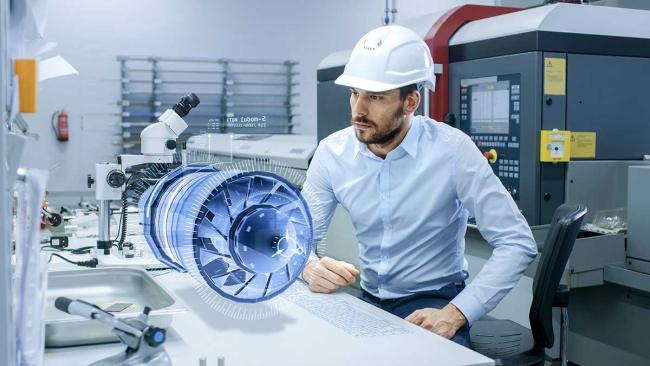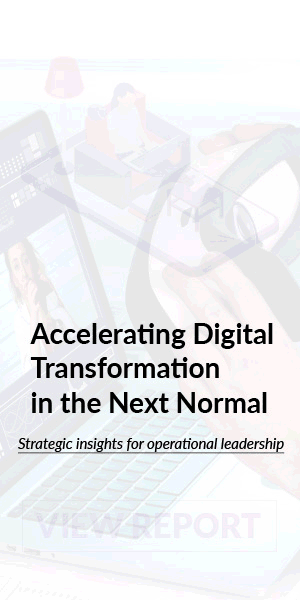
Longevity Industries - President, Founder
LINK Systems - Innovation Strategist / Sales Eng
With his 30-year career in the forming and fabricating industries, Phillips has been involved with safety and automation integration with companies and installations worldwide. Previously, he has worked as a director of fabrication products and designer. Phillips is regarded as an expert in the field of safety and Smart Mfg. He is a frequent speaker for MI Safety Conference and the Precision Metalforming Association. His commitment to manufacturing can be heard in his Longevity Industries’ “Destiny of Manufacturing” podcast where he interviews thought leaders and industry experts on their five-year outlook on the future of manufacturing. Find him on Twitter.
Topics
AR in Manufacturing Is Our Future, & the Future Is Now

If you work at the C-suite level, in operations or in the technology sector, it can often feel as though you’re falling behind if you don’t invest in every new technology! If so you’re not alone. However, in times of disruption, some technologies deserve extra attention, study and investment when deemed useful or essential. Augmented Reality (AR) is one such technology. In fact, in a recent study by CGS, “61 percent of operations leaders plan to invest in AR by the end of 2021.” (1)
As a leading innovation strategist, I recently completed a consultation project with the Michigan Safety Conference and Quartz Network on technology in safety and productivity. The concern from everyone has been how to keep up with technology and operations, especially in the areas of:
- Hiring and Retaining Skilled Workers
- Workplace Safety and Operational Efficiency
Technology has become central to operational performance in manufacturing because supporting a remote workforce places a high demand on resources. In short, technology is often the backbone of remote training solutions, and operations staff are responsible for deploying and supporting that technology. Therefore, more value is being placed on acquiring the right talent and operating efficiently while keeping personnel safe, especially during COVID-19.
Hiring and Retaining Skilled Workers
Recently the Precision Metalforming Association (PMA) found that millennials want to work for companies that are embracing technology. This is echoed in CGS’s 2021 Report for Operations Leaders, Supporting the Enterprise in a Post-COVID World(1). Their survey and research highlighted the importance executives are placing on technology and supporting the continuing trend of working remotely. Whether you’ve been in operations for many years or are just getting started, you know how difficult it can be to train personnel and make sure those individuals stay with the company. Now add the complexity of training remotely, and it can seem daunting.
In December 2020, 44 percent of operational leaders indicated that a majority of their team’s personnel are made up of deskless workers or are currently working remotely. More than one-quarter reported that over 75 percent of their staff were currently working remote/deskless.
The findings in the PMA study indicate that new hires want immersive experiences in and out of the workplace. They want to feel that they are working at a company that is staying up on technology and is current with advancements in training. And a Deskless Worker survey by CGS finds that 38 percent of Gen Z employees value training in the form of simulation exercises the most, demonstrating a need for organizations to expand their learning formats for this new technology-savvy generation entering the workforce.
In operations, our goal is to get the right people in the right positions and make sure they can achieve greatness. Rehiring and retraining wastes time and resources, a lot of time and resources. According to RecruiterBox, the average cost-per-hire in the manufacturing industry is $5,159. This means we are not even throwing good money after bad; we are reinvesting bad money on top of bad.
Manufacturers say it takes upwards of three months to fill openings for engineers, researchers and scientists, and in turn, these vacant positions impact several business areas, notably productivity (51 percent), growth (47 percent), customer service (42 percent) and innovation (43 percent).
Good money yields long-term returns. The operational leaders in the CGS survey identify Augmented Reality as being a solution to many of these problems because it blends instructor-led training with real-world situations to create real muscle memory and speed up the learning process. Augmented Reality has illustrated some of the opportunities it provides by using what we already know: It’s hard to retain information if the experience is not immersive.
Workplace Safety and Operational Efficiency
Modern manufacturing units are required to produce big batches of high-quality products while meeting tight deadlines to keep up with ever-increasing market demands. But this also requires that manufacturing facilities strike a perfect balance between operational efficiency and employee safety. The numbers from OSHA indicate that injuries often occur to inexperienced and untrained personnel. Their recommendation: improved training. According to the 2019 Liberty Mutual Safety Index, injuries cost the manufacturing industry more than $7.62 billion in 2019. While these costs are staggering on their own, the fact that nearly $2 billion of that can be mitigated through proper employee training is even more eye-opening.
AR’s high level of collaboration available through experiential technology is extremely valuable in achieving training goals. And more importantly, well-trained staff can engage with customers more communicatively and collaboratively. Troubleshooting devices and services is a snap with remote viewing and step-by-step problem-solving. Customer service and employee satisfaction both benefit from the latest technology. And in times like the pandemic, it allows for safe, effective and fast resolution if you focus on the solution and don’t get hung up on the problem.
5 Signs That the Time for AR Is Now
The supply chain was a big challenge throughout 2020. Some industry leaders thought they had learned what to do after the 2011 Tohoku tsunami in Japan. However, after COVID-19, we realized we were still putting all our eggs in one basket while simultaneously increasing the throughput in the same channels.
AR can be used to modernize the supply chain. Blockchain and similar technologies offer several advantages for traceability. They can integrate with sorting technology to help warehouses and logistics manage inventory and freight forwarding in a way that streamlines the throughput and improves the layer of information that is needed in C-suite meetings. Several logistics companies are extensively testing and deploying new AR technologies.
-
One area of the CGS report that was surprising to me was the statistic that only 5 percent of those in Operations roles are using augmented reality as the vehicle to take the company to that next level. Perhaps in some organizations, when they look at their current toolbox, they do not see AR listed yet. Instead, they opt to value and expand on what they already have, collaboration and communication tools. So, they put 14x the focus on those instead.
-
Any technology that will impact the throughput of business operations must be quick to deploy. AR is exceptional in this area, since it adapts to existing spaces. You don’t need to design a fictitious world and backgrounds, as in Virtual Reality. Instead, AR uses real-world locations and augments those with interfaces. It can engage a person with the same devices and materials they use at home or find in the work environment.
-
In today’s remote and hybrid workplace, many companies are looking to upgrade collaboration software and to improve communication tools,. These technologies are important, but they will not yield some of the advantages most people need long-term. Sure, staff can share documents and conduct meetings, but they still lack the value of a real-world Gemba walk. Companies need a way to be on-site together without the risks and travel costs of being on-site. In the past year of shutdowns and social distancing, many companies found out that deeper collaboration, even in situations that required expert eyes and ears to be on the problem at an actual location, is a good replacement for travel.
-
AR offers the opportunity to see and understand visually what may be difficult to convey in words alone. Using overlays on smartphone or tablet apps, remote personnel can provide expertise that cannot be found locally, no travel required.
Think about one expert in Louisiana being able to serve all the world from their home. This person can relate their knowledge and experience while viewing the environment remotely and interact with a local individual.
Now flip this upside-down. One expert on location with many remote students. They can see through the experts’ eyes as information is imparted and questions are answered.
Cincinnati Incorporated is a manufacturer leading in the deployment of augmented reality as a field service tool. They have found great value in both visual tools overlaying a screen and in using wearable displays. Wearables free up the technician to use their hands for testing and making adjustments. This real-world value has been accentuated by users in the field and even in the research world, such as those being done currently by Purdue University.
-
In the CGS report (1), I found one more point startling. I’m surprised that 74 percent of people in technical services have not explored AR. When it comes to a simple diagnosis, it’s far better to get on your computer for 15 minutes and use AR to assist a customer/staff member than it is to drive an hour out and an hour back. The healthcare community certainly has not overlooked AR’s use; virtual medicine, telehealth visits and simple diagnoses have exploded in recent years.
Technologically challenged companies may need AR more than anyone else to be competitive. They are already short in staff and equipment, so technology can be a key ingredient. If they don’t have 20 IT people and an office filled with computer science engineers to service their customers with less, AR is a great equalizer.
In the past, companies would send out a small army of highly skilled technicians across the globe to service equipment. Today you can do this with augmented reality and a handful of technicians or moderately experienced technical advisors. This is also true for the consumer side. When your company needs a technician immediately, you used to pay thousands of dollars to fly in an expert from another region or country. Today it’s a 30-minute call using AR technology.
If any of these uses or stories resonated with you, Augmented Reality is too crucial for your success for you to be left behind!
1: Supporting the Enterprise in a Post-COVID World, CGS, Inc., March 2021

Longevity Industries - President, Founder
LINK Systems - Innovation Strategist / Sales Eng
With his 30-year career in the forming and fabricating industries, Phillips has been involved with safety and automation integration with companies and installations worldwide. Previously, he has worked as a director of fabrication products and designer. Phillips is regarded as an expert in the field of safety and Smart Mfg. He is a frequent speaker for MI Safety Conference and the Precision Metalforming Association. His commitment to manufacturing can be heard in his Longevity Industries’ “Destiny of Manufacturing” podcast where he interviews thought leaders and industry experts on their five-year outlook on the future of manufacturing. Find him on Twitter.

